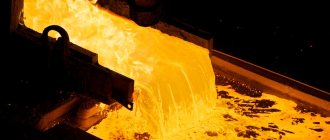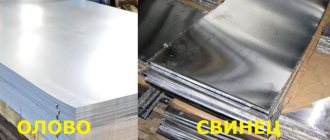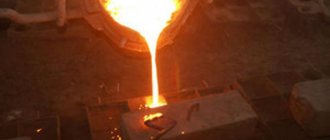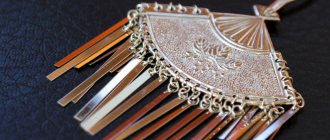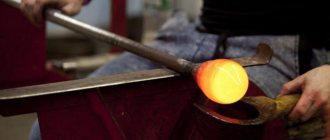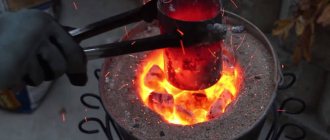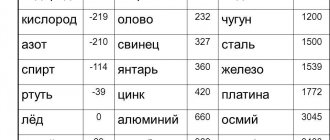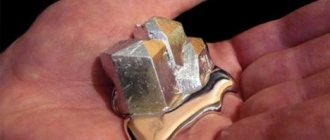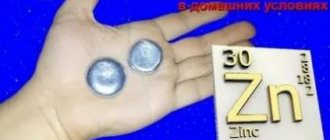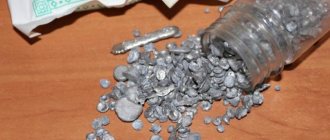Due to the fact that the melting point of copper is quite low, this metal was one of the first that ancient people began to use to make various tools, dishes, jewelry and weapons. Copper nuggets or copper ore could be melted over a fire, which is what our distant ancestors actually did.
Copper melting stage
Despite its active use by mankind since ancient times, copper is not the most common natural metal. In this respect, it is significantly inferior to the other elements and occupies only 23rd place in their series.
Being in nature
Native copper
Chalcopyrite CuFeS2, also known as copper pyrite, chalcocite Cu2S and bornite Cu5FeS4 are of industrial importance. Together with them, other copper minerals are also found: covellite CuS, cuprite Cu2O, azurite Cu3(CO3)2(OH)2, malachite Cu2CO3(OH)2. Sometimes copper is found in native form. The largest nugget was found in North America, and its weight was 420 tons [2]. Copper sulfides are formed mainly in medium-temperature hydrothermal veins. Copper deposits are also often found in sedimentary rocks - cuprous sandstones and shales. The most famous deposits of this type are Udokan in the Chita region, Dzhezkazgan in Kazakhstan, the copper belt of Central Africa and Mansfeld in Germany.
Most copper ore is mined by open pit mining. The copper content in the ore ranges from 0.4 to 1.0%.
Cuprum: element characteristics
The scientific name of copper Cuprum comes from the name of the Greek island of Cyprus, where copper mining began in the middle of the third millennium BC. In the periodic table of Mendeleev, the chemical element copper has atomic number 29 and is located in group 11 of the fourth period. Belongs to the ductile transition metals. In its pure form it has a characteristic golden-pink color. Pure copper is easy to oxidize, so under natural conditions it always forms a thin oxide film on its surface, which gives it a reddish tint.
Physical properties
This is the second metal after silver in terms of electrical conductivity, which makes it extremely popular in modern electronics. The second valuable quality is high thermal conductivity, which allows it to be widely used in all kinds of heat exchangers and refrigeration equipment.
- Melting point 1083 degrees.
- Boiling point 2567 degrees.
- The resistivity at 20 degrees is 1.68·10 -3 Ohm·m.
- Density 8.92 g/cm.
Being in nature
It occurs in nature in native form and in the form of compounds.
The largest deposits of native copper are located in the United States in the Lake Superior region. It was in this area that the largest copper nugget weighing 3560 kilograms was found. There is also a lot of native copper found in the ore mountains of Germany.
In Russia and the post-Soviet space, copper is mined by extracting it from sulfide ore. It can be mined by extracting it from copper pyrite or chalcopyrite CuFeS2. The most famous deposits are Udokan in Transbaikalia and Dzhezkazgan in Kazakhstan.
Copper sulfites most often form in so-called mid-temperature hydrothermal veins. They can also form in sedimentary rocks in the form of cuprous sandstones and shales.
As a rule, copper ore is always mined by open pit mining. The percentage of pure copper in the ore ranges from 0.2 to 1.0 percent depending on the deposit.
Copper alloys
They are the very first metal alloys, the production of which humanity mastered at the very dawn of its development. At what temperature copper melts depends on what alloy it is in. Currently, the most famous and in demand alloys are:
- Brass. An alloy with the addition of zinc, the content of which can reach up to 40%. Zinc increases the ductility and strength of the metal. The temperature at which brass melts is 880 - 950 degrees.
- Bronze. An alloy with tin, with the addition of some other components such as silicon, beryllium, lead. Man learned to make bronze from copper at the very beginning of the Bronze Age. Bronze did not lose its relevance even with the advent of the Iron Age; for example, at the beginning of the 20th century, gun barrels were made from so-called gun bronze. The temperature at which bronze begins to melt is 930 - 1140 degrees.
- Cupronickel. In addition to copper, it contains 5-30% nickel. Nickel increases the strength of the copper alloy and increases its electrical resistance. In addition, corrosion resistance is greatly improved. Melting point - 1170 degrees. In its external characteristics, cupronickel is very similar to silver; it used to be called white copper. But it has higher mechanical strength than ordinary silver.
- Dural, or duralumin. The bulk of the alloy is aluminum 93%, copper accounts for 5%, the remaining 2% is occupied by manganese, iron and magnesium. The name comes from the name of the German city of Düren, where this high-strength aluminum alloy was first produced in 1906. One of its features is the fact that its strength characteristics tend to increase over time. Therefore, it does not lose its strength after several years of use, like other metals. Currently, this alloy is the basis of aircraft construction.
- Jewelry alloys. Alloys of copper and gold. This increases the resistance of the precious metal to mechanical stress and abrasion.
Read also: Differential pressure gauge for gas
Physical properties
Copper is a golden-pink ductile metal; in air it quickly becomes covered with an oxide film, which gives it a characteristic intense yellowish-red hue. Copper has high thermal and electrical conductivity (it ranks second in electrical conductivity after silver). It has two stable isotopes - 63Cu and 65Cu, and several radioactive isotopes. The longest-lived of these, 64Cu, has a half-life of 12.7 hours and two decay modes with different products.
There are a number of copper alloys: brass is an alloy of copper and zinc, bronze is an alloy of copper and tin, cupronickel is an alloy of copper and nickel, and some others.
Copper alloys
Alloys that increase the strength and other properties of copper are obtained by introducing additives into it, such as zinc, tin, silicon, lead, aluminum, manganese, and nickel. More than 30% of copper is used for alloys.
Brass - alloys of copper and zinc (copper from 60 to 90% and zinc from 40 to 10%) - is stronger than copper and less susceptible to oxidation. When silicon and lead are added to brass, its anti-friction qualities increase; when tin, aluminum, manganese and nickel are added, its anti-corrosion resistance increases. Sheets and cast products are used in mechanical engineering, especially in chemical, optics and instrument making, and in the production of meshes for the pulp and paper industry.
Bronze. Previously, bronzes were alloys of copper (80-94%) and tin (20-6%). Currently, tin-free bronzes are produced, named after the main component after copper.
- Aluminum bronzes contain 5-11% aluminum and have high mechanical properties combined with anti-corrosion resistance.
- Lead bronzes containing 25-33% lead are used mainly for the manufacture of bearings operating at high pressures and high sliding speeds.
- Silicon bronzes containing 4-5% silicon are used as cheap substitutes for tin bronzes.
- Beryllium bronzes containing 1.8-2.3% beryllium are distinguished by hardness after hardening and high elasticity. They are used for the manufacture of springs and spring products.
- Cadmium bronzes - copper alloys with a small amount of cadmium (up to 1%) - are used in the production of trolley wires, for the manufacture of fittings for water and gas lines and in mechanical engineering.
Solders are alloys of non-ferrous metals used in soldering to produce a monolithic soldered seam. Among hard solders, copper-silver alloy is known (44.5-45.5% Ag; 29-31% Cu; the rest is zinc).
Bronze
Bronze
Non-ferrous metal has been used for the manufacture of various types of products since ancient times. This fact is confirmed by materials found during archaeological excavations. The composition of bronze was originally rich in tin.
The industry produces a different number of varieties of bronze. An experienced craftsman is able to determine its purpose by the color of the metal. However, not everyone can determine the exact grade of bronze; markings are used for this. Methods for producing bronze are divided into casting, when melting and casting occurs, and deforming.
The composition of the metal depends on its intended use. The main indicator is the presence of beryllium. The increased concentration of the element in the alloy, subjected to a hardening procedure, can rival high-strength steels. The presence of tin in the composition takes away the flexibility and ductility of the metal.
The production of bronze alloys has changed since ancient times with the introduction of modern equipment. The technology using charcoal as a flux is still used today. Sequence for obtaining bronze:
- the furnace is heated to the required temperature, after which a crucible is installed in it;
- after melting, the metal may oxidize; to avoid this, flux is added as charcoal;
- Phosphorus copper serves as an acid catalyst; addition occurs after the alloy is completely heated.
Bronze smelting
Antique bronze products are subject to natural processes - patination. The greenish color with a white tint appears due to the formation of a film enveloping the product. Artificial patination methods include methods using sulfur and parallel heating to a certain temperature.
Brass
Brass
An alloy based on copper with the addition of zinc is called brass. In some situations, tin is added in smaller proportions. James Emerson decided to patent the combination in 1781. The zinc content in the alloy can vary from 5 to 45%. Brass is distinguished depending on its purpose and specification:
- simple, consisting of two components - copper and zinc. The marking of such alloys is indicated by the letter “L”, directly indicating the copper content in the alloy as a percentage;
- multi-component brasses - contain many other metals depending on their intended use. Such alloys increase the performance properties of products; they are also designated by the letter “L”, but with the addition of numbers.
The physical properties of brass are relatively high, corrosion resistance is at an average level. Most alloys are not critical to low temperatures; it is possible to operate the metal in various conditions. Technologies for producing brass interact with the processes of the copper and zinc industry, processing of secondary raw materials. An effective method of melting is to use an induction-type electric furnace with a magnetic tap and temperature control. After obtaining a homogeneous mass, it is poured into molds and subjected to deformation processes.
Melting brass
The use of the material in various industries increases the demand for it every year. The alloy is used in court construction and the production of ammunition, various bushings, adapters, bolts, nuts and plumbing materials.
Copper connections
Copper (I) oxide Cu2O3 and cuprous oxide (I) Cu2O , like other copper (I) compounds, are less stable than copper (II) compounds. Copper (I) oxide, or cuprous oxide Cu2O, occurs naturally as the mineral cuprite. In addition, it can be obtained as a precipitate of red copper(I) oxide by heating a solution of a copper(II) salt and an alkali in the presence of a strong reducing agent.
Copper(II) oxide, or copper oxide, CuO is a black substance found in nature (for example, as the mineral tenerite). It is obtained by calcination of copper (II) hydroxycarbonate (CuOH)2CO3 or copper (II) nitrate Cu(NO2)2. Copper(II) oxide is a good oxidizing agent.
Copper (II) hydroxide Cu(OH)2 precipitates from solutions of copper (II) salts under the action of alkalis in the form of a blue gelatinous mass. Even with low heating, even under water, it decomposes, turning into black copper (II) oxide. Copper(II) hydroxide is a very weak base. Therefore, solutions of copper (II) salts in most cases have an acidic reaction, and with weak acids copper forms basic salts.
Copper (II) sulfate CuSO4 in the anhydrous state is a white powder that turns blue when it absorbs water. Therefore, it is used to detect traces of moisture in organic liquids. An aqueous solution of copper sulfate has a characteristic blue-blue color. This color is characteristic of hydrated [Cu(H2O)4]2+ ions, therefore all dilute solutions of copper (II) salts have the same color, unless they contain any colored anions. From aqueous solutions, copper sulfate crystallizes with five molecules of water, forming transparent blue crystals of copper sulfate. Copper sulfate is used for electrolytic coating of metals with copper, for the preparation of mineral paints, and also as a starting material in the preparation of other copper compounds. In agriculture, a diluted solution of copper sulfate is used to spray plants and treat grain before sowing to destroy spores of harmful fungi.
Copper (II) chloride CuCl2. 2H2O. Forms dark green crystals, easily soluble in water. Very concentrated solutions of copper (II) chloride are green, diluted solutions are blue-blue.
Copper (II) nitrate Cu(NO3)2.3H2O. It is obtained by dissolving copper in nitric acid. When heated, blue copper nitrate crystals first lose water and then easily decompose, releasing oxygen and brown nitrogen dioxide, turning into copper (II) oxide.
Copper (II) hydroxycarbonate (CuOH)2CO3. It occurs naturally in the form of the mineral malachite, which has a beautiful emerald green color. It is artificially prepared by the action of Na2CO3 on solutions of copper (II) salts. 2CuSO4 + 2Na2CO3 + H2O = (CuOH)2CO3v + 2Na2SO4 + CO2^ Used to obtain copper (II) chloride, for the preparation of blue and green mineral paints, as well as in pyrotechnics.
Copper (II) acetate Cu (CH3COO)2.H2O. It is obtained by treating copper metal or copper(II) oxide with acetic acid. Usually it is a mixture of basic salts of various compositions and colors (green and blue-green). Under the name verdigris, it is used to prepare oil paint.
Complex copper compounds are formed as a result of the combination of doubly charged copper ions with ammonia molecules. A variety of mineral paints are obtained from copper salts. All copper salts are poisonous. Therefore, to avoid the formation of copper salts, copper utensils are coated on the inside with a layer of tin (tinned).
Connections
Copper sulfate
In copper compounds, there are two oxidation states: the less stable Cu+ and the much more stable Cu2+, which gives blue and blue-green salts. Under unusual conditions, compounds with an oxidation state of +3 and even +5 can be obtained. The latter is found in salts of the cuprabrane anion Cu(B11H11)23-, obtained in 1994.
Copper(II) carbonate has a green color, which is the reason for the greening of elements of buildings, monuments and copper products. Copper(II) sulfate, when hydrated, gives blue crystals of copper sulfate CuSO4∙5H2O, and is used as a fungicide. There is also unstable copper(I) sulfate. There are two stable copper oxides - copper(I) oxide Cu2O and copper(II) oxide CuO. Copper oxides are used to produce yttrium barium copper oxide (YBa2Cu3O7-δ), which is the basis for the production of superconductors. Copper(I) chloride is colorless crystals (white powder in bulk) with a density of 4.11 g/cm³. Stable when dry. In the presence of moisture, it is easily oxidized by atmospheric oxygen, acquiring a blue-green color. Can be synthesized by reducing copper(II) chloride with sodium sulfite in aqueous solution.
Methods for obtaining copper
In nature, copper exists in compounds and in the form of nuggets. The compounds are represented by oxides, bicarbonates, sulfur and carbon dioxide complexes, as well as sulfide ores. The most common ores are copper pyrite and copper luster. The copper content in them is 1-2%. 90% of primary copper is mined using the pyrometallurgical method and 10% using the hydrometallurgical method.
1. The pyrometallurgical method includes the following processes: enrichment and roasting, smelting for matte, purging in a converter, electrolytic refining. Copper ores are enriched by flotation and oxidative roasting. The essence of the flotation method is as follows: copper particles suspended in an aqueous medium adhere to the surface of air bubbles and rise to the surface. The method allows you to obtain copper powder concentrate, which contains 10-35% copper.
Copper ores and concentrates with a significant sulfur content are subject to oxidative roasting. When heated in the presence of oxygen, sulfides are oxidized, and the amount of sulfur is reduced by almost half. Poor concentrates containing 8-25% copper are roasted. Rich concentrates containing 25-35% copper are melted without resorting to roasting.
The next stage of the pyrometallurgical method for producing copper is smelting for matte. If lump copper ore with a large amount of sulfur is used as a raw material, then smelting is carried out in shaft furnaces. And for powdered flotation concentrate, reverberatory furnaces are used. Melting occurs at a temperature of 1450 °C.
In horizontal converters with side blowing, the copper matte is blown with compressed air in order for the oxidation of sulfides and ferrum to occur. Next, the resulting oxides are converted into slag, and sulfur into oxide. The converter produces blister copper, which contains 98.4-99.4% copper, iron, sulfur, as well as small amounts of nickel, tin, silver and gold.
Blister copper is subject to fire and then electrolytic refining. Impurities are removed with gases and converted into slag. As a result of fire refining, copper is formed with a purity of up to 99.5%. And after electrolytic refining, the purity is 99.95%.
2. The hydrometallurgical method involves leaching copper with a weak solution of sulfuric acid, and then separating copper metal directly from the solution. This method is used for processing low-grade ores and does not allow for the associated extraction of precious metals along with copper.
Origin and occurrence of copper in nature
The chemical element got its name from the name of the island of Cyprus (Cuprum), where they learned to extract it back in the 3rd millennium BC. In the periodic table of chemical elements, copper has atomic number 29 and is located in group 11 of the 4th period. The element is a ductile transition metal with a golden-pink color.
In terms of distribution in the earth's crust, the element ranks 23rd among other elements and is most often found in the form of sulfide ores. The most common types are copper pyrite and copper luster. Today there are several ways to obtain copper from ore , but any of the technologies requires a step-by-step approach to achieve the final result.
At the very beginning of the development of civilization, people learned to obtain and use copper, as well as its alloys. Already at that distant time, they were mining not sulfide, but malachite ore. In this form, it did not require preliminary roasting. A mixture of ore and coals was placed in a clay vessel, which was lowered into a small pit, after which the mixture was set on fire, carbon monoxide helped restore malachite to the state of free copper.
In nature, copper is found not only in ore, but also in native form; the richest deposits are located in Chile. Copper sulfides often form in mid-temperature geothermal veins. Often copper deposits can be in the form of sedimentary rocks - shales and copper sandstones, which are found in the Chita region and Kazakhstan.
This is interesting: How and with what to clean brass at home
Extraction methods
Copper is mined by open and closed methods. The first is relevant if the ore is located in a thickness of up to 500 meters. For deeper deposits, special underground mines are built. Pure copper is obtained mainly by the pyrometallurgical method, less often by the hydrometallurgical method.
The pyrometallurgical technique is conventionally divided into two stages, and uses chalcopyrite (copper sulfate) as the feedstock. The first stage is flotation or oxidative roasting. The purpose of this technology is the enrichment of copper ore, which has a high sulfur concentration. During processing, sulfur is removed up to 1%, other metals contained in the ore are converted into oxide compounds.
Chemical formulas of the process:
- ZnS + 1.5O2 = ZnO + SO2 + Q – the reaction occurs at a temperature exceeding +800 degrees;
- ZnS + 2O2 = ZnSO2 + Q – the optimal temperature varies within +600/+700 degrees.
After this, the enriched ore is melted in shaft furnaces at a temperature of + 14,500 degrees, transforming into an alloy consisting of iron and copper sulfides (matte). To improve quality, converter blowing is carried out without fuel supply. The copper content in this alloy is approximately 91%. The second stage is refining, after which the copper component increases to 99.9%.
The hydrometallurgical method is based on leaching. To do this, the ore is crushed into small pieces and filled with solvents:
- NH4OH;
- H2SO4;
- Fe (SO4).
The result is a solution in which copper and other metals are released. Process formulas:
- CuO+H2SO4>CuSO4+H2O – leaching with sulfuric acid;
- CuSO4+2Fe2SO4>4FeSO4+2CuSO+S – use of iron sulfate;
- Cu2S + 2 Fe2 (SO4)3>2 CuSO4 + 4 FeSO4 + S – leaching with iron sulfate.
The resulting solution undergoes subsequent processing to extract the metal. For example, the cementation technique can be used: CuSO4 + Fe>FeSO4 + Cu. Here pieces of iron are added to the composition, replacing the copper component in sulfate salts.
Copper Applications
Due to their valuable qualities, copper and copper alloys are used in the electrical and electrical engineering industries, in radio electronics and instrument making. There are alloys of copper with metals such as zinc, tin, aluminum, nickel, titanium, silver, and gold. Less commonly used are alloys with non-metals: phosphorus, sulfur, oxygen. There are two groups of copper alloys: brass (alloys with zinc) and bronze (alloys with other elements).
Copper is highly environmentally friendly, which allows its use in the construction of residential buildings. For example, a copper roof, due to its anti-corrosion properties, can last more than a hundred years without special care or painting.
Copper in alloys with gold is used in jewelry. This alloy increases the strength of the product, increases resistance to deformation and abrasion.
Copper compounds are characterized by high biological activity. In plants, copper takes part in the synthesis of chlorophyll. Therefore, it can be seen in the composition of mineral fertilizers. A lack of copper in the human body can cause deterioration in blood composition. It is found in many food products. For example, this metal is found in milk. However, it is important to remember that excess copper compounds can cause poisoning. This is why you should not cook food in copper cookware. During boiling, large amounts of copper can leach into food. If the dishes inside are covered with a layer of tin, then there is no danger of poisoning.
In medicine, copper is used as an antiseptic and astringent. It is a component of eye drops for conjunctivitis and solutions for burns.
Independent copper smelting
For many people, smelting copper and making all kinds of products from it is an exciting hobby. Those who want to devote their free time to melting metal need to prepare the following devices for work:
- muffle furnace;
- pure raw materials;
- heat-resistant crucible;
- fireproof stand;
- steel wire hook;
- tongs for removing the crucible from the oven;
- personal protective equipment: suit, glasses, gloves.
Actions are performed according to the instructions:
- They put on a special suit.
- The raw materials are crushed and placed in a crucible.
- Place in the oven and set the desired temperature. The metal should not be allowed to boil.
- When the set temperature is reached, open the door, grab the crucible with tongs, remove it from the oven, and place it on a refractory stand.
- Using a steel hook, the oxide film formed as a result of melting is moved to the edges of the container.
- The liquid copper mass is poured into a special container and cooled.
- In powerful muffle furnaces, red copper and all kinds of alloys can be melted.
Melting with a torch
It should be remembered that a nitrogen environment is important during melting. For low-melting copper alloys, brass or some brands of bronze, you can use a regular gas burner. For this you will need:
- feedstock;
- special forms;
- tongs for removing metal from a hot working surface;
- high pressure burner running on gas;
- protective equipment: suit, glasses, gloves.
The alloy melting technology is as follows:
- The raw materials are highly crushed. This can be done using a file, turning the material into sawdust.
- Place in a special form made of heat-resistant material.
- Wear a protective suit, goggles, and thick gloves.
- Light the burner.
- The heating device is directed with free movements along the body of the container. To achieve quick results, the flame should touch the surface with the blue tip. In this place of the torch the temperature is highest.
- After the solid has melted, the crucible is grabbed with tongs.
- The liquid mass is poured into the desired form.
If you don't have a gas burner, you can use an ordinary blowtorch.
When casting non-ferrous alloys, every craftsman must remember safety precautions:
- The room where work is carried out must have good ventilation.
- To avoid burns, it is necessary to work in personal protective equipment.
Optimal air temperature, acceptable air humidity, cleanliness of the workplace, low concentration of harmful atmospheric substances, good illumination of the space are factors that help to avoid injuries.
Melting point of copper
Under normal conditions, the melting point of copper is 1083 degrees Celsius. And during heating, a number of transformations occur at the molecular level, which leads to a change in the properties of the substance. To understand all these changes, you need to consider the main stages of heating and melting a copper ingot. An approximate copper melting graph looks like this:
- In the normal state, at temperatures from 0 to 100 degrees, a strong crystal lattice is formed inside copper, which provides the material with greater stability, elasticity, and chemical inertness. The lattice is quite strong, but in the case of severe deformation, a spatial change in the position of atoms in the lattice can occur. This explains the malleability and ductility of copper products, which can be bent and deformed (say, during forging or in the case of a press).
- Under normal conditions, at temperatures from 0 to 100 degrees, a thin oxide film also forms on the surface of the copper product. The presence of such a film is a big plus for the product, since it performs many important functions - it minimizes contact with external substances, protects the material from corrosion, and slightly increases strength. If the material is cooled below 0 degrees, the copper itself retains all its physical properties. However, when cooled, the oxide film becomes less elastic and dense, and the product becomes less hard (although from a practical point of view this decrease in strength is almost imperceptible).
- When the material is heated above a temperature of 100 degrees, gradual destruction of the oxide film on the metal surface occurs. This increases the chemical reactivity of the material, making it susceptible to exposure to substances in the external environment. At the same time, when heated, copper atoms are saturated with energy, which makes the material more plastic. For this reason, forging of copper products is carried out precisely after heating, since without heating, changing the shape of the product will require a large amount of physical effort (this may be the muscular strength of the blacksmith, the cost of electricity to run an electric press, and so on).
- When the temperature reaches 1083 degrees, the crystalline copper lattice begins to gradually collapse, which turns solid copper into liquid. At the physical level, the following happens - due to excess energy, atoms begin to move in the crystal lattice more intensely and chaotically, which leads to frequent collisions of atoms with each other. Ultimately, this destroys the lattice, although due to mutual collision and attraction the atoms do not fly apart in different directions. At the physical level, this structure of the material corresponds to a liquid (that is, a state of matter in which the atoms are in relatively free movement, but do not fly apart in different directions like a gas).
- When the copper liquid cools below a temperature of 1083 degrees, the substance gradually crystallizes. The copper regains its solid form (the lower the temperature, the more intense the solidification of the substance occurs). However, if necessary, liquid copper can be further heated (at the chemical level, the atoms will be further saturated with energy). When the temperature reaches 2595 degrees Celsius, the liquid will begin to boil and the copper will begin to take on gaseous form. In practice, long-term retention of a substance in gaseous form is problematic - upon contact with atmospheric air, the substance will quickly cool, turning back into a liquid. To overcome this limitation, different technologies are used. The optimal method is heating the substance in a refractory chamber while maintaining a stable temperature above the critical point (that is, above a temperature of 2595 degrees). In this case, the temperature of the environment will be high, and cooling of the substance will not occur.
To melt/evaporate a copper product using a high-precision heating device, it is recommended to heat to a slightly higher temperature. For example, in the case of melting, the product should be heated to a temperature of 1100-1200 degrees (and not 1083 degrees). From a practical point of view, this is explained simply - the heating of the substance occurs unevenly, so some fragments of the copper product will hold their shape for a long time, while others will quickly melt. In addition, the substance will constantly cool, which can lead to crystallization of individual fragments of the melt.
At what temperature does copper melt?
Melting occurs when a metal changes from a solid state to a liquid state. Each element has its own melting point. Much depends on the impurities in the metal . The normal melting point of copper is 1083 ° C. When tin is added, the temperature drops to 930-1140 ° C. The melting point here depends on the tin content of the alloy. In an alloy of cuprum and zinc, melting occurs at 900-1050 ° C.
When any metal is heated, its crystal lattice is destroyed. As it heats up, the melting point increases, but then levels off once a certain temperature limit is reached. At this moment the metal melts. It melts completely and the temperature rises again.
When the metal cools, the temperature decreases, at a certain point it remains at the same level until the metal hardens completely. After complete hardening, the temperature drops again. This is demonstrated by the phase diagram, which shows the temperature process from the beginning of melting to solidification. When heated, heated copper at 2560 ° C begins to boil. Boiling is similar to the boiling of liquid substances, when gas is released and bubbles appear on the surface. At the moment of boiling at the highest possible temperatures, the release of carbon formed during oxidation begins.
Melting copper based alloys
In practice, copper is used not only as a pure substance, but also in the form of various alloys. Examples of such alloys are bronze, brass, cupronickel and others. Since alloys are multicomponent substances, their melting occurs according to a different principle. Let's consider an approximate algorithm for melting copper alloys using brass as an example:
- At temperatures up to 100 degrees Celsius, the crystal lattice is stable and homogeneous. In the event of an impact, the material is deformed. On the surface of the material there is a thin oxide film that protects the product from exposure to water, atmospheric air, and chemically active substances.
- When brass is heated to 100 degrees, the outer film gradually melts, which makes the substance less durable. Also, due to damage to the protective film, the chemical activity of the material increases (that is, it begins to react more actively with water, air, and chemicals). The crystal lattice is resistant to slight heat, so the material retains its shape.
- The temperature of 880 degrees is the solidus point. When this temperature is reached, the melting of the most fusible elements that make up the alloy begins. This leads to a partial transition of the solid into a liquid. At the chemical level, when the solidus point is reached, the crystal lattice of the substance is partially destroyed, but in the more refractory fractions the lattice is preserved.
- A temperature of 950 degrees is the liquidus point. When this mark is reached, the most refractory fractions melt, which retain their hardness at lower temperatures. As a result, at the chemical level, the material becomes completely liquid, since the crystal lattice of all components that make up the brass is completely destroyed.
Graph of metal melting temperature versus pressure
Sequencing
Smelting can be carried out in several ways:
- Smelting using a muffle furnace. The metal is crushed into pieces. The smaller the pieces used, the faster the melting will occur. The pieces are poured into a crucible, which, once filled, is placed in the oven. The oven is preheated to the desired temperature. In serially manufactured furnaces, a window is provided through which the smelting process can be monitored. After the metal has melted, the crucible is removed from the muffle furnace using steel tongs. There is an oxide film on the surface of liquid copper. It must be moved with a steel hook to the edge of the crucible. After these steps, the copper is carefully but quickly poured into a pre-prepared mold.
- Melting using a gas burner. If you don’t have a crucible furnace at your disposal, a gas burner is quite suitable instead. It should be placed under the bottom of the container with metal, making sure that the flame covers the entire surface of the bottom of the crucible. With this method, the metal will quickly oxidize due to open air access. To avoid this, you can pour a layer of crushed charcoal into the container.
- Melting with a blowtorch. This method is more suitable for working with lower-melting copper-based alloys. The process is the same as with a gas burner.
- Smelting using a forge or a home vacuum cleaner. In this case, a container with metal is placed on a layer of burning charcoal. Such a stove can be made of refractory bricks. To create a suitable temperature, you need to organize air supply. This can be done in two ways - using a forge or a household vacuum cleaner. When using a vacuum cleaner, it will be necessary to make a metal adapter with a nozzle of a smaller diameter.
Muffle furnace and gas burner
Pure copper does not have good enough fluidity to make complex products. For such purposes, it is better to use brass, and you should keep in mind that the lighter the alloy, the lower its melting point.
How to melt copper at home?
Typically, copper and alloys based on it are melted in special furnaces, where not only the material is melted, but also new parts are formed. However, if desired, copper products can be melted at home. The melting temperature of copper at home will be standard - 1083 degrees. Experienced metallurgists recommend heating the substance with a small margin in order to minimize heat loss and prevent re-crystallization of the substance when it is cooled. Safety precautions must be followed when melting at home. Below we will look at these rules, and then find out exactly how to melt copper products at home.
Muffle furnace
A laboratory muffle is the most convenient device for melting metal.
Some tips on how to melt a copper alloy in the laboratory:
- the muffle furnace has a temperature regulator knob, it must be set to a mark slightly higher than the melting temperature of the alloy;
- The graphite or ceramic crucible is heated well before loading the charge;
- After casting, scale is removed from the hot crucible using a wire hook.
The casting in the muffle is heated evenly, the melter is isolated from volatile harmful components. Through the fireproof glass of the door it is convenient to observe the progress of copper melting.
Gas-burner
Copper smelting in small volumes is carried out with a manual gas torch. The power of a portable device does not matter much. The burner is placed under the crucible in which copper scrap will be melted, the flame is directed to the bottom, the tongues should cover it completely. The process is labor-intensive and lengthy. To protect against oxygen, colored scrap is sprinkled with coal chips.
Horn
Copper is smelted at home using a crucible furnace or forge. It is a limited space where the crucible is placed on a stand. The coals are lit from below or a burner is brought in. It is necessary to organize air supply to increase the combustion temperature of the fuel. To speed up the melting process, cover the top of the forge with a tight lid. Well-hot charcoal is heated and poured into a crucible with a crowbar. The method is used by specialists who often do small-scale casting.
Blowtorch
An alloy with zinc and tin melts at a low temperature. A conventional blowtorch is used as an energy source for melting; it is placed vertically under the crucible so that the flame covers the surface of the bottom and the lower part of the side wall. To reduce the volume of scale, the scrap is sprinkled with charcoal. The oxidation process during melting under a layer of coal chips will not proceed as intensely.
Microwave
You can melt copper at home in the microwave; remove the turning mechanism from it. A fireproof container with a fireclay brick lid is made to match the size of the crucible. First, the ceramic crucible is heated at maximum mode for 15 minutes, it warms up to a yellowish glow. Then the prepared scrap is poured into it, the fireclay container is put back into the furnace, the copper scrap needs to be melted for 20-30 minutes at maximum mode, a temperature of about +1200°C is created. The alloy is then poured into a pre-prepared mold or mold.
For the manufacture of small parts, it is better to choose multicomponent alloys: brass, bronze, they are not so fluid, they are easier to melt, and do not require too high temperatures. When smelting copper at home, safety precautions are followed and fire safety measures are in place.
- home
- Technologies
Copper melting chart
The melting of any metal consists in the fact that under the influence of high temperatures the crystal lattice is destroyed and the metal passes from a solid to a liquid state. It is possible to identify some regularities that are characteristic of any metal during the melting process:
- During heating, the temperature inside the metal rises, but the crystal lattice is not destroyed. The metal retains its solid state.
- When the melting point is reached, for copper this is 1083 degrees, the temperature inside the metal stops increasing, despite the fact that general heating and heat transfer continue.
- After the entire mass of metal passes into the molten state, the temperature inside the metal again begins to rise sharply.
In the case of the cooling process of molten metal, the same thing happens, but in the reverse order. First, there is a sharp decrease in the temperature inside the metal, then at 1080 degrees the temperature drop stops until the entire mass of the metal turns into a solid state. After this, the temperature again begins to drop sharply until it becomes equal to the temperature of the surrounding air and crystallization is completely completed.
Boiling temperature
Copper begins to actively release carbon in the form of gas bubbles at a temperature of 2560 degrees. Outwardly, this is very similar to boiling water. In fact, this is a process of active oxidation of copper, as a result of which the metal loses almost all of its unique properties. Parts cast from boiling copper have a large number of pores in their structure, which will reduce the mechanical strength of the material and worsen its decorative properties. Therefore, during the smelting process, it is necessary to carefully monitor the temperature and prevent the copper from boiling.
Characteristics of copper smelting methods
Copper smelting at home and in production is the same. The process of changing state is carried out under the influence of increasing temperature. With enough heat, the metal structure of the object is destroyed. This effect can be achieved in several ways.
Muffle furnace
What does a muffle furnace consist of
? Casting using a laboratory muffle furnace, which has an adjustable heating temperature. This is a pretty simple method. The raw materials are pre-crushed into pieces. The smaller they are, the faster the melting will be.
The prepared material is placed in a graphite crucible and placed in a preheated oven. The mold for pouring must have a melting point higher than that of copper. The mass-produced heating device is equipped with a special window that allows you to monitor the technological process.
When the copper reaches a liquid state, the crucible is removed from the furnace using iron tongs. Using a wire hook, the oxide film is removed from the surface of the molten metal to the edges of the crucible. After the manipulations have been completed, the liquid consistency is carefully poured into a pre-prepared container.
Gas-burner
Copper smelting is also carried out using a gas torch. If you don’t have a crucible furnace, a hand-held portable gas burner is quite suitable. It must be placed under the bottom of the container with metal and ensure that the flame completely covers the bottom.
The method allows the material to quickly oxidize, as it involves close contact with air. To prevent the formation of a thick oxide film, the molten mass is sprinkled with crushed charcoal.
Blowtorch
Casting copper using a blowtorch occurs in the same way as with a gas burner. The method is applicable for low-melting metals.
Horn
You can melt copper or its alloys with a forge.
To do this, place a crucible with crushed metal on well-heated charcoal. To speed up the process, use a home vacuum cleaner turned on in blowing mode. The pipe should be of small diameter with an iron tip, since the plastic will melt under the influence of high temperature. The method is ideal for those people who regularly do metal casting in large volumes.
Microwave
A powerful microwave oven with a modified design will help melt copper. To do this, remove the rotating tray. A muffle furnace is made from refractory bricks, into which the starting material is placed. The device is necessary to increase the heat-saving properties of raw materials and protect equipment elements from overheating.
Pure copper is difficult to melt because it has poor fluidity in liquid form. Experts do not recommend making small and complex parts from such material. Multicomponent compounds based on brass, tin or zinc, which do not require high temperatures, are suitable for this.

